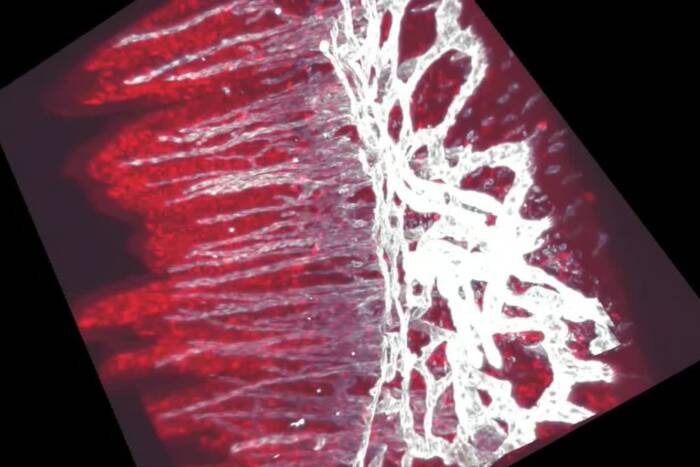Safe science: The fight against caustic splashes, toxic waste, and other common lab threats
by Julie Grisham, freelance writer

Wear your protective gear. Chemical spills and needle sticks are among the most common lab injuries reported by Rockefeller employees.
In every Rockefeller lab and office, people are dedicated to improving human health, and the Office of Laboratory Safety and Environmental Health is no exception. In fact, its team members support the university’s mission by maintaining the health of one special group of humans—Rockefeller employees, volunteers, visitors, and students.
“Rockefeller has always prided itself on being the best we can be when it comes to employee safety,” says Frank Schaefer, Director of Laboratory Safety and Environmental Health. “We’re ahead of the curve with many of our safety practices, compared with many other biomedical research institutions. And we work very hard to make sure everyone gets the training and support they need.”
Work-related injuries or illnesses are rare at Rockefeller—there were a total of 33 reported injuries in over 2.7 million hours worked here in 2014—but they do happen. “One of the most important contributors to employee safety in the lab is proper use of personal protective equipment,” Mr. Schaefer says. He adds that this point was driven home by several high-profile lab accidents at other universities in recent years, including a lab fire at the University of California, Los Angeles, in 2008 that killed a young research assistant who was not wearing proper safety equipment.
Maintaining a culture of safety
At Rockefeller, everyone who works in a lab is issued safety glasses and flame-resistant lab coats. Gloves, respirators, and other personal protective equipment are available to personnel who need them. “But even though we know personal protective equipment is so important, we still need to urge people to wear it,” Mr. Schaefer says. “In 2014, we had four reportable injuries due to people not wearing eye protection. Chemical spills can happen in any lab, and people may get splashes on their skin if they are not wearing a lab coat and gloves. We’ve had workers who received chemical burns on their feet because they weren’t wearing proper closed-toe shoes.”
Other common injuries are needle sticks or cuts from other sharp objects. Some of these incidents can be more severe if infectious agents are involved. Less common but still potentially serious lab injuries are bites or scratches from research animals.
Safety is regulated by many different entities, including the Occupational Health and Safety Administration (OSHA), the Environmental Protection Agency, the Centers for Disease Control and Prevention, the Nuclear Regulatory Commission, and the New York Fire Department, to name a few. Issues that fall under the guidance of Rockefeller’s Laboratory Safety and Environmental Health team include how hazardous materials are used, stored, and disposed of; protecting employees who may lift heavy objects or face physical hazards as part of their work duties; and ensuring that university operations have a minimal impact on the environment.
Safety is an important part of the university’s culture. A one-hour safety orientation is part of every new employee’s training, and most people complete additional training related specifically to their job responsibilities. Online training is offered for staff and students who work with biological agents, radioactive materials, hazardous chemicals, or certain types of equipment. OSHA requires additional training for many support staff personnel as well, including those in Plant Operations, Housing, and the Comparative Bioscience Center.
A personal approach
Although Rockefeller offers online training modules to address mandated and common safety training, Mr. Schaefer finds that face-to-face interactions are the most beneficial to lab workers—and to him. “My mission, and the mission of my office, is to aid and enhance research through safe work practices,” he says. “I enjoy going to lab meetings and talking to people about safety issues that pertain to their particular projects. Some of Rockefeller’s labs are so specialized, and they vary dramatically based on the kinds of research they do. A lot of questions and issues come up in these meetings, reminding all of us of the importance of doing things the right way.”
Mr. Schaefer, who received bachelor’s and master’s degrees in environmental safely and occupational health, has been interested in these topics since hearing news coverage of the 1984 tragedy in Bhopal, India, in which thousands of people lost their lives after a poisonous gas leak at a Union Carbide chemical plant. “I expected I’d be out cleaning up Superfund sites, but what I’m doing at Rockefeller is equally important work,” he says. “I’m helping people and I’m helping to protect the environment, and every day I learn something new.”
Employees and students are encouraged to discuss any concerns they have with the Office of Laboratory Safety and Environmental Health. “We’re here to help and to support you,” Mr. Schaefer says. “Our department is a resource for everyone, so please call us if you have a problem.”
The office can be reached by email or at 212-327-8324.


